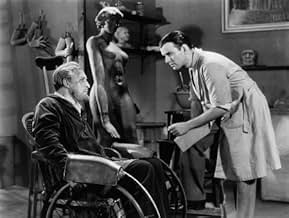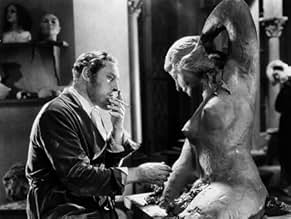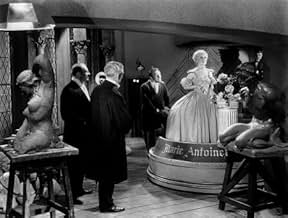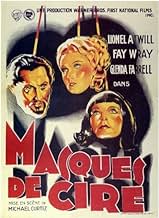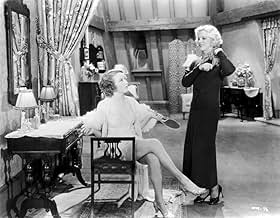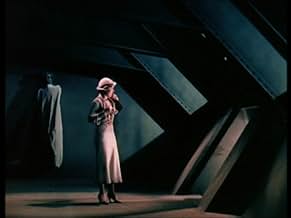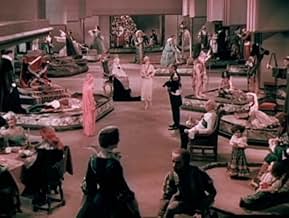PUNTUACIÓN EN IMDb
6,8/10
7,3 mil
TU PUNTUACIÓN
En un museo de cera, un curador enmascarado transforma a la gente en estatuas y busca a su siguiente María Antonieta.En un museo de cera, un curador enmascarado transforma a la gente en estatuas y busca a su siguiente María Antonieta.En un museo de cera, un curador enmascarado transforma a la gente en estatuas y busca a su siguiente María Antonieta.
- Dirección
- Guión
- Reparto principal
Thomas E. Jackson
- Detective
- (as Thomas Jackson)
Bull Anderson
- Janitor
- (sin acreditar)
Frank Austin
- Winton's Valet
- (sin acreditar)
Max Barwyn
- Museum Visitor
- (sin acreditar)
Wade Boteler
- Ambrose
- (sin acreditar)
Reseñas destacadas
This film, which was remade as "House Of Wax" 20 years later (as if you didn't know), might not enjoy quite the reputation it does today had it not been the basis for the better-known later film and, more importantly, believed lost for over 30 years, which made it something of a legend for many people who'd never even seen it. Legendary status can be rather difficult to live up to, and unless a viewer is approaching it with no advance knowledge of its history, MYSTERY OF THE WAX MUSEUM may not be quite what one expects.
It is, nevertheless, an energetic and entertaining amalgam of genres: horror film meets newspaper crime drama. Dropping a rather Gothic tale of body-snatching, a mad sculptor and a museum of wax-covered corpses into the streamline-moderne milieu of fast-talking, wise-cracking reporters on the trail of a hot story makes for interesting contrasts.
Lionel Atwill, as Ivan Igor, the artist driven to insanity and murder by the destruction of his wax "children" in an arson fire, was an immensely enjoyable performer whose best work came a bit later (see "Son Of Frankenstein" for his portrayal of the one-armed Insp. Krogh). His natural screen presence carries him through, though he never quite generates either the pathos or the smooth menace that Vincent Price displayed in the remake. But from the moment of her entrance, it's Glenda Farrell as Florence Dempsey, the reporter out to save her job by bringing in a scoop - barreling onto the screen with a full head of steam - who propels the story all the way to its finish.
There's an awful lot going on here beyond the basic premise; bootlegging, a "dope fiend," a suicide and a falsely implicated millionaire playboy are thrown into the mix, packing quite a lot into the 77 minute running time (the remake improved the story by eliminating extraneous characters and subplots). A pre-"King Kong" Fay Wray (in her naturally red hair sans the "Kong" blond wig) is the damsel in actual distress, but despite her billing, she's basically a supporting player and has little to do - beyond enduring roommate Florence's snide comments about her penniless boyfriend - until the climactic confrontation between all the bad guys and good guys (and girls).
MYSTERY is well-served by the direction of Michael Curtiz ("Adventures Of Robin Hood," "Casablanca"), who was something of a jack-of-all-genres, and there's plenty of snappy dialogue, some of which (Florence asking a cop, "How's your sex life?") wouldn't have made it to the screen a year later under the newly re-written Production Code. Depending on one's point of view, it could be said that the very effective production design either benefits, or suffers, from the pale pastels of the two-strip Technicolor photography. For my part, I'm guessing that the subdued tones we see today result from the lack of first-rate film elements available. Having seen far superior two-strip from years earlier, I'll wager that the original prints were much more vivid.
If you're any kind of a fan of the remake, you do owe it to yourself to see this one, if only once. There are many things to enjoy in MYSTERY OF THE WAX MUSEUM, not the least of which are the fabulous ensembles worn by Farrell. Just how does a newspaper reporter one step away from the breadline afford a wardrobe like that?
It is, nevertheless, an energetic and entertaining amalgam of genres: horror film meets newspaper crime drama. Dropping a rather Gothic tale of body-snatching, a mad sculptor and a museum of wax-covered corpses into the streamline-moderne milieu of fast-talking, wise-cracking reporters on the trail of a hot story makes for interesting contrasts.
Lionel Atwill, as Ivan Igor, the artist driven to insanity and murder by the destruction of his wax "children" in an arson fire, was an immensely enjoyable performer whose best work came a bit later (see "Son Of Frankenstein" for his portrayal of the one-armed Insp. Krogh). His natural screen presence carries him through, though he never quite generates either the pathos or the smooth menace that Vincent Price displayed in the remake. But from the moment of her entrance, it's Glenda Farrell as Florence Dempsey, the reporter out to save her job by bringing in a scoop - barreling onto the screen with a full head of steam - who propels the story all the way to its finish.
There's an awful lot going on here beyond the basic premise; bootlegging, a "dope fiend," a suicide and a falsely implicated millionaire playboy are thrown into the mix, packing quite a lot into the 77 minute running time (the remake improved the story by eliminating extraneous characters and subplots). A pre-"King Kong" Fay Wray (in her naturally red hair sans the "Kong" blond wig) is the damsel in actual distress, but despite her billing, she's basically a supporting player and has little to do - beyond enduring roommate Florence's snide comments about her penniless boyfriend - until the climactic confrontation between all the bad guys and good guys (and girls).
MYSTERY is well-served by the direction of Michael Curtiz ("Adventures Of Robin Hood," "Casablanca"), who was something of a jack-of-all-genres, and there's plenty of snappy dialogue, some of which (Florence asking a cop, "How's your sex life?") wouldn't have made it to the screen a year later under the newly re-written Production Code. Depending on one's point of view, it could be said that the very effective production design either benefits, or suffers, from the pale pastels of the two-strip Technicolor photography. For my part, I'm guessing that the subdued tones we see today result from the lack of first-rate film elements available. Having seen far superior two-strip from years earlier, I'll wager that the original prints were much more vivid.
If you're any kind of a fan of the remake, you do owe it to yourself to see this one, if only once. There are many things to enjoy in MYSTERY OF THE WAX MUSEUM, not the least of which are the fabulous ensembles worn by Farrell. Just how does a newspaper reporter one step away from the breadline afford a wardrobe like that?
Michael Curtiz has over 170 directing credits, including "The Jazz Singer." Of the films on that list which I have seen, this is my favourite. It's filled with some quite amazing dolly and camera work, the story is fun and the acting is solid.
This story has had a long life. This film, was based on a play. In 1953, it was re-made as a Vincent Price vehicle, "House of Wax" in 3-D. And in 2005, it was re-made again as a teen slasher. The premise is solidly creepy.
Glenda Farrell is hilarious as the young journalist. Her energy leaps off the screen. I guess audiences of 1933 needed quite a bit of comic relief to make it through the rest of this.
Lionel Atwill's make-up is fantastic. It's no surprise that it was designed by a Westmore: Hollywood's premiere make-up family.
This was shot in a two-colour Technicolor process which makes the entire film rather distinctive and moody. The fantastic film noir lighting adds to it as well.
If you can find this, it's a definite must-see! There are so many images and ideas borrowed from it in later horror films it's interesting to see their origins.
This story has had a long life. This film, was based on a play. In 1953, it was re-made as a Vincent Price vehicle, "House of Wax" in 3-D. And in 2005, it was re-made again as a teen slasher. The premise is solidly creepy.
Glenda Farrell is hilarious as the young journalist. Her energy leaps off the screen. I guess audiences of 1933 needed quite a bit of comic relief to make it through the rest of this.
Lionel Atwill's make-up is fantastic. It's no surprise that it was designed by a Westmore: Hollywood's premiere make-up family.
This was shot in a two-colour Technicolor process which makes the entire film rather distinctive and moody. The fantastic film noir lighting adds to it as well.
If you can find this, it's a definite must-see! There are so many images and ideas borrowed from it in later horror films it's interesting to see their origins.
Considering the fact that this 1933 movie was produced during the depression, when moviegoers expected pure entertainment, the results were exactly what they wanted. Glenda Farrell's hard-boiled Florence Dempsey was what filmgoers were looking for. Please note that many of the movies of the period had male and female stars who were fast talkers and wise-crackers. Such stars as Cary Grant, Carole Lombard, Rosalind Russell, Bette Davis, James Cagney, Mae West, W. C. Fields, William Powell, Myrna Loy, etc. were the norm and not the exception.
This wonderful movie was way ahead of its time. It's two-color look was also something very different for the 1930s and its washed-out looked helped give it a more sinister appearance. The later "House of Wax" used 3-D and having seen it in the movies I can tell you it was probably the best of the 3-D movies. Even better than "The Creature from the Black Lagoon".
Fay Wray was pure candy and she practiced her scream well for the upcoming "King Kong". I have seen most of Lionel Atwill's work and I believe the underplaying of Ivan Igor helped make him a more credible monster. The movie was well cast and one can not help but notice the uncanny fact that most of the actors in "The House of Wax" were chosen because they looked like the earlier actors except for the difference between Charles Buchinsky (Bronson) and Matthew Betz as the loyal mute assistant.
Although enjoyable, "The House of Wax" was no match for the earlier edition. It's understandable that "The House of Wax" did not use the characters of Florence Dempsey and Gavin Gordon. Sidekicks didn't work as well as in the 50s.
I wonder what the movie critics of the 30s thought of the "Mystery of the Wax Museum?"
This wonderful movie was way ahead of its time. It's two-color look was also something very different for the 1930s and its washed-out looked helped give it a more sinister appearance. The later "House of Wax" used 3-D and having seen it in the movies I can tell you it was probably the best of the 3-D movies. Even better than "The Creature from the Black Lagoon".
Fay Wray was pure candy and she practiced her scream well for the upcoming "King Kong". I have seen most of Lionel Atwill's work and I believe the underplaying of Ivan Igor helped make him a more credible monster. The movie was well cast and one can not help but notice the uncanny fact that most of the actors in "The House of Wax" were chosen because they looked like the earlier actors except for the difference between Charles Buchinsky (Bronson) and Matthew Betz as the loyal mute assistant.
Although enjoyable, "The House of Wax" was no match for the earlier edition. It's understandable that "The House of Wax" did not use the characters of Florence Dempsey and Gavin Gordon. Sidekicks didn't work as well as in the 50s.
I wonder what the movie critics of the 30s thought of the "Mystery of the Wax Museum?"
Classic horror movie directed by Michael Curtiz and starring Lionel Atwill as a deranged sculptor with an "interesting" method of making the statues on display at his wax museum. The last (and best) of the three horror movies Lionel Atwill did with Fay Wray. Atwill is fantastic here and Wray is, as always, delightful. Nice support from Frank McHugh, Gavin Gordon, and Edwin Maxwell, among others. The scene stealer of the movie is Glenda Farrell as the fast-talking reporter heroine. She really has fun with the part. A few years later she would star in the Torchy Blane series and play a character very similar to the one she plays here.
It's a good-looking movie, filmed in two-color Technicolor with nice atmospheric direction from Curtiz. The sets are great, especially Atwill's art deco laboratory. The makeup effects are terrific. It's a juicy Pre-Coder, as evidenced by the gruesome plot and the junkie character played by Arthur Edmund Carewe. Some viewers might be put off by the fact that a large chunk of the middle of the picture is more like a crime story/newspaper movie but I was always entertained, particularly by the back & forth between Farrell and McHugh. So it's not a straight horror movie from beginning to end but, so what, it's still a great film and worth a look. Remade in the '50s as House of Wax with Vincent Price. That version is more well-known than this one but I like rewatching this one more. It's just more fun.
It's a good-looking movie, filmed in two-color Technicolor with nice atmospheric direction from Curtiz. The sets are great, especially Atwill's art deco laboratory. The makeup effects are terrific. It's a juicy Pre-Coder, as evidenced by the gruesome plot and the junkie character played by Arthur Edmund Carewe. Some viewers might be put off by the fact that a large chunk of the middle of the picture is more like a crime story/newspaper movie but I was always entertained, particularly by the back & forth between Farrell and McHugh. So it's not a straight horror movie from beginning to end but, so what, it's still a great film and worth a look. Remade in the '50s as House of Wax with Vincent Price. That version is more well-known than this one but I like rewatching this one more. It's just more fun.
These days, Mystery of the Wax Museum has become best known for the fact that it was the film that spawned the 1953 classic starring Vincent Price. This is somewhat unfair, however, as although this film isn't a brilliant masterpiece, or even genre classic, it has a right to remembered in it's own right. The film is actually quite daring and inventive for the time when it was made; and despite the fact that nothing too bad is graphically shown, for obvious reasons, some of the imagery on display does actually succeed in being quite disturbing. Take the deformed face of the central character for example; it won't keep you up all night, but considering the time when this was made; the effects are good. The two-strip Technicolor style of the film gives it something of a unique feel; and this again is to it's credit as the film has aged really, really well. The plot line will be familiar to anyone who has seen the Vincent Price version, but here, aside from a museum proprietor that gets his life work melted away in an inferno; we've got a press investigation into the affairs as well.
Lionel Atwill takes the lead role as the unfortunate victim of the flames, and while he's certainly no Vincent Price; he does well with what he's got and helps to create a macabre surrounding around his character, which in turn helps the film in the atmosphere department. Joining him are Glenda Farrell and Fay Wray as the heroine's of the story. Wray plays the girl that the unfortunate artist becomes obsessed with, and Farrell gives a slightly irritating, but very lively performance as a journalist. Both do well with their roles, and although this film isn't exactly an exhibition in acting (unlike Curtiz's masterpiece, Casablanca); the cast do well enough. One thing that is unfortunate for this film is that it's seen as a second feature for the Price version, which will harm what some viewers think of it as the plot elements are very similar to the 1953 film, so it can, at times, feel as though you're simply watching the same film again. However, if viewed as a stand-alone product, Mystery of the Wax Museum represents a solid 30's horror movie and I can see why any horror fan wouldn't enjoy it.
Lionel Atwill takes the lead role as the unfortunate victim of the flames, and while he's certainly no Vincent Price; he does well with what he's got and helps to create a macabre surrounding around his character, which in turn helps the film in the atmosphere department. Joining him are Glenda Farrell and Fay Wray as the heroine's of the story. Wray plays the girl that the unfortunate artist becomes obsessed with, and Farrell gives a slightly irritating, but very lively performance as a journalist. Both do well with their roles, and although this film isn't exactly an exhibition in acting (unlike Curtiz's masterpiece, Casablanca); the cast do well enough. One thing that is unfortunate for this film is that it's seen as a second feature for the Price version, which will harm what some viewers think of it as the plot elements are very similar to the 1953 film, so it can, at times, feel as though you're simply watching the same film again. However, if viewed as a stand-alone product, Mystery of the Wax Museum represents a solid 30's horror movie and I can see why any horror fan wouldn't enjoy it.
¿Sabías que...?
- CuriosidadesThis film was produced before the Production Code. When it was remade 20 years later, as Los crímenes del museo de cera (1953), all references to drug use were removed, and a character was changed from a junkie to an alcoholic.
- PifiasIvan Igor says that Jean Paul Marat's assassin, Charlotte Corday, was his mistress. This is incorrect; they never had met until she came to his office posing as a courier and quickly stabbed him to death. After her execution a few days later, she was found to be virgo intacta.
- Versiones alternativasThis film was shot in two versions. One camera unit shot the film in two-color Technicolor. A second camera unit shot the scenes at the same time in black and white. The black and white version was meant for theaters who could not afford the higher rental cost of the color prints.
- ConexionesEdited into Ante todo, mujer (1974)
Selecciones populares
Inicia sesión para calificar y añadir a tu lista para recibir recomendaciones personalizadas
Detalles
- Duración
- 1h 17min(77 min)
- Relación de aspecto
- 1.37 : 1
Contribuir a esta página
Sugerir un cambio o añadir el contenido que falta


